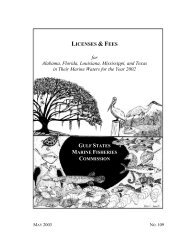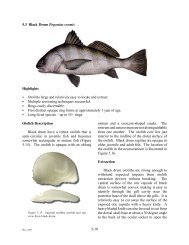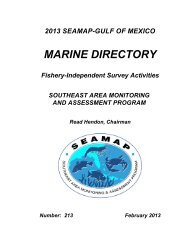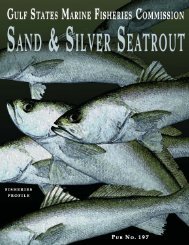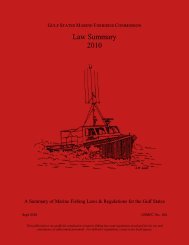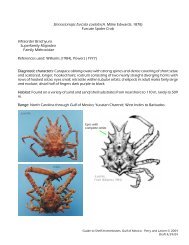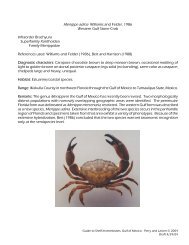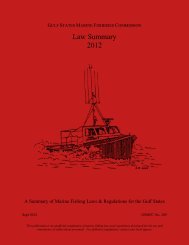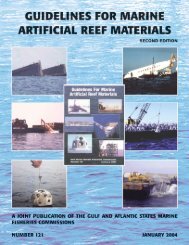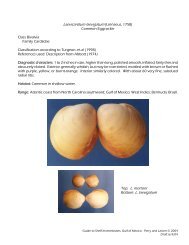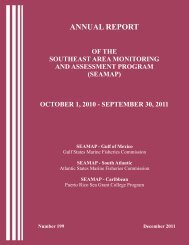Basic Commercial Fishing Regulations - Gulf States Marine ...
Basic Commercial Fishing Regulations - Gulf States Marine ...
Basic Commercial Fishing Regulations - Gulf States Marine ...
Create successful ePaper yourself
Turn your PDF publications into a flip-book with our unique Google optimized e-Paper software.
Menhaden<br />
Legal Gear - Purse Seine: Cannot be used to take<br />
finfish other than menhaden or herring like species.<br />
Use is otherwise prohibited in inside or outside waters<br />
as delineated in LA. R.S. 56:495.<br />
Regular Menhaden Season: The season for the taking<br />
of menhaden as well as processing of menhaden<br />
shall be from the third Monday in April through Nov.<br />
1. The menhaden season shall apply to all waters seaward<br />
of the inside-outside line described in R.S.<br />
56:495 including waters in the Federal Exclusive<br />
Economic Zone (EEZ), and in Chandeleur and Breton<br />
Sounds LAC 76:VII.307.D. All other inside waters<br />
and passes are permanently closed to menhaden fishing.<br />
Menhaden Bait Season: runs from after the close of<br />
the regular menhaden season until Dec. 1. If the quota<br />
has not been reached by Dec. 1, then, beginning on<br />
April 1 of the following year, bait gulf menhaden may<br />
be taken until LDWF determines that the quota (3,000<br />
metric tons) has been met. Any menhaden taken pursuant<br />
to this special season shall be sold only for use as<br />
bait. The Secretary shall grant special permits for the<br />
taking of menhaden during the special bait season.<br />
Anyone legally harvesting menhaden cannot possess<br />
more than 5 percent, by weight, of any species other<br />
than menhaden and herring-like species.<br />
Mullet, Striped<br />
Mullet Permit: The commercial fisherman (captain)<br />
is required to qualify and purchase a mullet permit to<br />
commercially harvest mullet. Mullet permit required<br />
in addition to other licenses, qualifications exist.<br />
Qualifying criteria for Mullet Permit are:<br />
1. applicant must have possessed a valid saltwater<br />
gill net license during two of the years 1993, 1994<br />
or 1995.<br />
2. applicant must provide positive proof, in the form<br />
of state and federal income tax returns, including<br />
Schedule C of the federal 1040 form, submitted in<br />
accordance with procedures established by the<br />
commission, that the applicant has derived more<br />
than fifty percent of his income earned from the<br />
capture and sale of seafood species in at least two<br />
of the three years, 1993, 1994 or 1995.<br />
Legal Gear - Mullet Strike Net: Mullet may only be<br />
taken commercially with a mullet strike net. One and<br />
three-fourth inches square or three and one-half inches<br />
stretched mesh (minimum). No mullet strike net in use<br />
can exceed 1,200 feet in length or be unattended by the<br />
licensee thereof. Mullet strike nets may only be used<br />
in state waters for the legal taking of striped mullet<br />
with a special mullet permit during the commercial<br />
season.<br />
<strong>Commercial</strong> season: From the third Monday in<br />
October until the third Monday in the following<br />
January. No commercial harvest of mullet is allowed<br />
outside this season. Mullet strike nets may be used<br />
Monday through Friday from sunrise to sunset. Only<br />
one mullet strike net may be in use from any vessel at<br />
any time. A commercial fisherman must have in possession<br />
a valid LDWF mullet permit in his name for<br />
legal harvest and sale. Mullet strike nets must be<br />
tagged with an LDWF issued tag. No other fish may<br />
be possessed when mullet fishing.<br />
Strike net gear licenses are non-transferable.<br />
Pompano, Florida<br />
Pompano Permit: A commercial fisherman is required<br />
to obtain a pompano permit to commercially harvest<br />
and sell pompano using a pompano strike net in Breton<br />
and Chandeleur sounds during the pompano season.<br />
Legal Gear - Pompano Strike Net: In addition to<br />
other legal gears, Florida pompano can be harvested<br />
with pompano strike nets in seasons and areas described<br />
below. Two and one-half inches square or five inches<br />
stretched mesh (minimum). No pompano strike net in<br />
use shall exceed 2,400 feet in length or be unattended<br />
by the licensee thereof. Pompano strike nets may only<br />
be used for the legal taking of pompano in the waters<br />
in excess of seven feet in depth and beyond 2,500 feet<br />
from land within the Chandeleur and Breton Sound<br />
areas described in R.S. 56:406(A)(2). Pompano strike<br />
nets may be used from Aug. 1 - Oct. 31 of each year.<br />
Reef Fish<br />
To commercially harvest or sell certain reef fish<br />
species listed below (triggerfishes, amberjacks, wrasses,<br />
snappers, groupers and tilefishes) whether taken<br />
within or without the territorial waters of Louisiana,<br />
fishermen must possess a permit issued by the National<br />
<strong>Marine</strong> Fisheries Service for the <strong>Gulf</strong> of Mexico Reef<br />
Fish Resources. Contact:<br />
National <strong>Marine</strong> Fisheries Service,<br />
Southeast Regional Office<br />
263 13th Avenue South<br />
St. Petersburg, FL 33701<br />
(727) 824-5305<br />
(For permit related inquiries 727-824-5326)<br />
For a person on board a vessel to fish for or possess<br />
<strong>Gulf</strong> Reef fish in the <strong>Gulf</strong> EEZ, the vessel must<br />
possess on board and such person must use the gear as<br />
specified below:<br />
1. Non-stainless steel circle hooks - required when<br />
fishing with natural baits for reef fish<br />
2. Dehooking device - at least one device is required<br />
and must be used to remove hooks embedded in<br />
<strong>Gulf</strong> reef fish with minimum damage.<br />
A. The hook removal device must be constructed<br />
to allow the hook to be secured and the barb<br />
shielded without re-engaging during the<br />
removal process.<br />
B. The dehooking end must be blunt and all edges<br />
rounded.<br />
26<br />
124



